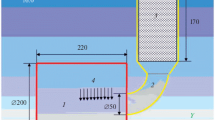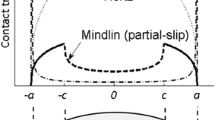Abstract
When a metal matrix composite undergoes centrifugal casting, the velocity, deceleration, displacement, and segregation of its particles are modeled according to changes in the centrifugal radius, as well as by variations in the molten metal viscosity as the temperature decreases during the cooling process. A cast aluminum alloy A356 reinforced by 10 V% of silicon carbide particles (SiC), with a median diameter of 12 μm, was used to conduct the experiments, and a mathematical modeling showed that the particles’ volume fraction on the outer casting face varied according to whether the viscosity of the liquid metal used was constant or variable. If variations in viscosity during the cooling process are taken into account, then the volume fraction of the particles for a given time of centrifugation changes on the outer casting face, while it increases if the viscosity was constant. Modeling the particle segregation with variable viscosity produces results that are closer to those obtained with experiments than is the case when a constant viscosity is used. In fact, the higher the initial pouring and mold temperatures, the higher the effect of the viscosity variation on particle segregation.














Similar content being viewed by others
Abbreviations
- ω:
-
Angular velocity, rad/s
- γ:
-
Acceleration, mm/s2
- F net :
-
Net force on the particle, N
- F ω :
-
Centrifugal force, N
- F η :
-
Viscous force, N
- F R :
-
Repulsive force, N
- R 0 :
-
Particle position at time t = 0, mm
- d p :
-
Particle diameter, mm
- R p :
-
Particle radius, mm
- ρp :
-
Particle density, kg/m3
- ρl :
-
Liquid density, kg/m3
- η:
-
Metal viscosity, Pa · s
- η c :
-
Apparent viscosity, Pa · s
- K m :
-
Thermal conductivity of the matrix, W/m · K
- V p :
-
Particle volume fraction, %V
- \( v_{{{\text{p}}(t_{i} )}} \) :
-
Particle velocity at time t i , mm/s
- \( V_{{{\text{p}}(t_{i} \to \, t_{i} + \Updelta t)}} \) :
-
Particle velocity at time interval (t i → t i + ∆t), mm/s
- V c :
-
Cooling rate, °C/s
- \( a_{{t_{i} }}^{{R_{j} }} \) :
-
Particle acceleration as a function of time and position, mm/s2
- Q :
-
Activation energy of viscous flow, kJ/mol
- R g :
-
Constant of perfect gases, J/K · mol
- Δt :
-
Time increment, s
- \( R_{{t_{i} + \Updelta t}} \) :
-
Centrifugal radius at time t i + ∆t, mm
- \( R_{{t_{i} }} \) :
-
Centrifugation radius at time t i , mm
- t i :
-
Centrifugation time, s
- t c :
-
Cooling time, s
- C :
-
Specific heat, J/kg · K−1
- H f :
-
Latent heat of fusion, J/kg
- \( T_{{{\text{m}},t_{i} }}^{{R_{j} }} \) :
-
Temperature of liquid metal as a function of time and position, °C
- \( T_{{{\text{m}},(t_{i} + \Updelta t)}}^{{R_{j} }} \) :
-
Molten metal temperature at time (t i + ∆t) and position R j , °C
- T L, T s :
-
Liquidus and solidius temperatures, respectively, °C
- T P :
-
Overheated metal temperature, °C
- α:
-
Coefficient
- Al:
-
Aluminum
- SiC:
-
Silicon carbide
- A :
-
Constant
- m:
-
Metal
- P:
-
Particle
- c:
-
Composite
- \( C_{\text{p}}^{{A_{i} }} \left| {_{i = 0}^{n} } \right. \) :
-
Concentration of the particles in an area A i , wt.%
- \( m_{\text{P}}^{{A_{i} }} \) :
-
Mass of the particles in an area A i , g
- \( m_{\text{T}}^{{A_{i} }} \) :
-
Total mass of the whole microstructure in an area A i , g
- R M,i :
-
Inner composite radius, mm
- R M,e :
-
Outer composite radius, mm
- R m,i :
-
Inner mold radius, mm
- d m,e :
-
Outer mold diameter, mm
- t s :
-
Solidification time, s
- V i :
-
Sub-volume, mm3
- L i :
-
Length, mm
- h :
-
Height, mm
- e :
-
Thickness, mm
- \( {\text{fv}}_{{V_{i} }}^{{t_{0} }} \) :
-
Volume fraction of particles corresponding to the volume V i at time t = 0, V%
- \( {\text{fv}}_{{ \to V_{i} }}^{{t_{\text{s}} }} \) :
-
Volume fraction of particles entering the sub volume V i at time t s, before the solidification begins on this volume, V%
- \( {\text{fv}}_{{V_{i} \to }}^{{t_{\text{s}} }} \) :
-
Volume fraction of particles leaving the volume V i at time t s , V%
- \( {\text{fv}}_{{V_{i} \left( {R_{j} - \Updelta R/2 < R_{{{\text{ini}} .}}^{t = 0} + S_{{(t_{i} ){\text{tot}}}}^{{R_{j} }} < R_{j} } \right)}}^{{t_{\text{s}} }} \) :
-
Volume fraction of particles moved to a sub volume V i located between R j and R j − ΔR/2 before the solidification begins, V%
- \( {\text{fv}}_{{V_{i} \left( {R_{j} < R_{{{\text{ini}} .}}^{t = 0} + S_{{(t_{i} ){\text{tot}}}}^{{R_{j} }} < R_{j} + \Updelta R/2} \right)}}^{{t{\text{s}}}} \) :
-
Volume fraction of particles moved to a sub volume V i located between R j and R j + ΔR/2 before the solidification begins, V%
- \( \Updelta {\text{fv}}_{{V_{i} + 1(s_{i} {\text{fv}}_{{(V_{i + 1} )}} > 52\% )}}^{{t_{\text{s}} }} \) :
-
Excess of the particles’ volume fraction of the sub volume V i+1, V%
- \( R({\text{fv}})_{j}^{{t_{\text{s}} }} \left| {_{j = 0}^{n} } \right. \) :
-
Final position of particles’ volume fraction before the solidification starts, mm
- \( R({\text{fv}})_{j}^{{t_{0} }} \left| {_{j = 0}^{n} } \right. \) :
-
Initial position of particles’ volume fraction, mm
- \( S_{{({\text{fv}})_{{R_{j} }} }}^{{t_{i} }} \) :
-
Displacement of the particles’ volume fraction located at an initial position (R j ) for a given time of centrifugation (t i ), before the solidification begins, mm
- \( v_{{t_{i} }}^{{R_{j} }} \) :
-
Velocity of particle located at an initial position (R j ) for a given time of centrifugation (t i ), mm/s
- ∆R :
-
Radius increment, mm
References
Y. Watanabe, N. Yamanaka, and Y. Fukui, Control of Composition Gradient in a Metal-Ceramic Functionally Graded Material Manufactured by the Centrifugal Method, Composites A, 1998, 29A, p 595–601
F. Bonollo, A. Moret, S. Gallo, and C. Mus, Cylinder Liners in Aluminum Matrix Composite by Centrifugal Casting, Metall. Italiana, 2004, 96, p 49–55
P.S.S. Raju and S.P. Mehrotra, Mathematical Modeling of Centrifugal Casting of Metal Matrix Composites, Mater. Trans. JIM, 2000, 41, p 1626–1635
A. Velhinho, P.D. Sequeira, F. Braz Fernandes, J.D. Botas, and L.A. Rocha, Al/SiCp Functionally Graded Metal-Matrix Composites Produced, by Centrifugal Casting: Effect of Particle Grain Size on Reinforcement Distribution, Presented at Proceedings of the Seventh International Symposium on Functionally Graded Materials, Oct 15–18 2002, Beijing, China, 423–425, 2003, p 257–262
M.F. Forster, R.W. Hamilton, R.J. Dashwood, and P.D. Lee, Centrifugal Casting of Aluminium Containing In Situ Formed TiB, Mater. Sci. Technol., 2003, 19, p 1215–1219
L. Lajoye and M. Suery, Modelling of Particle Segregation During Centrifugal Casting of Al-Matrix Composites, Proceedings of the International Symposium on Advances in Cast Reinforced Metal Composites, Sep 26–30, Chicago, IL, 1988, p 15–20
E. Panda, D. Mazumdar, and S.P. Mehrotra, Mathematical Modeling of Particle Segregation During Centrifugal Casting of Metal Matrix Composites, Metall. Mater. Trans. A, 2006, 37, p 1675–1687
D.R. Poirier and E.J. Poirier, Heat Transfer Fundamentals for Metal Casting, TMS, Warrendale, PA, 1991, p 1–59
A. Grabowski, M. Nowak, and J. Sleziona, Optical and Conductive Properties of AlSi-Alloy/SiC Composites: Application in Modelling CO2 Laser Processing of Composites, Opt. Lasers Eng., 2005, 43, p 233–246
D.M. Stefanescu, A. Moitra, A.S. Kacar, and B.K. Dhindaw, Influence of Buoyant Forces and Volume Fraction of Particles on the Particle Pushing/Entrapment Transition During Directional Solidification of Al/SiC and Al/Graphite Composites, Metall. Trans. A, 1990, 21A, p 231–239
Fluent 6.2 documentation, L:/fluent.inc/help/index.htm
R. Rodriguez-Castro and M.H. Kelestemur, Processing and Microstructural Characterization of Functionally Gradient Al A359/SiCp Composite, J. Mater. Sci., 2002, 37, p 1813–1821
Author information
Authors and Affiliations
Corresponding author
Rights and permissions
About this article
Cite this article
Balout, B., Litwin, J. Mathematical Modeling of Particle Segregation During Centrifugal Casting of Metal Matrix Composites. J. of Materi Eng and Perform 21, 450–462 (2012). https://doi.org/10.1007/s11665-011-9873-8
Received:
Revised:
Published:
Issue Date:
DOI: https://doi.org/10.1007/s11665-011-9873-8




